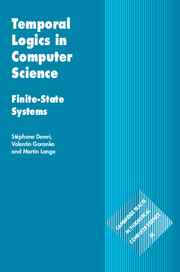10 - Expressiveness
from PART III - PROPERTIES
Published online by Cambridge University Press: 13 October 2016
Summary
A formula of a temporal logic expresses a temporal property of interpreted transition systems, for instance in order to specify formally some wanted or some unwanted behaviour of the system. With several logics at hand, a natural question arises that has already been introduced in Chapter 7 with the definition of several syntactic fragments of CTL*: what are the properties that can be formalised in a particular logic? And which ones cannot be formalised? The first question is answered, in a way, by all formulae of that logic, but this answer is pretty much useless for getting an idea of what is possible with that logic. A better way to address these questions is to look at the whole picture of all temporal logics. We can naturally compare two logics L1 and L2 by asking whether every property that is formalisable in L1 can also be formalised in L2. It is easily seen that this yields a preorder on all temporal logics of the same kind, for example all linear-time temporal logics or all branching-time temporal logics. Note that a temporal property can be identified with the class of (rooted) interpreted transition systems that possess this property. Thus, a formula from one logic being expressible by a formula in another logic simply amounts to the two formulae being equivalent in the usual logical sense, i.e. having the same families of models. For linear-time logics this is a family of computation paths, while for branching-time logics it is a family of rooted interpreted transition systems.
A careful analysis of what is possible in which logic should thus give us two hierarchies, of linear-time logics and of branching-time logics.Obviously, itwould be nice to unify them in one big picture which shows the expressive power of every temporal logic. For this we need to be able to compare a linear-time and a branching-time logic, and this can be done by regarding the former as a latter with implicit quantification over computation paths. When we identify a linear-time formula φ with the branching-time property Aφ or Eφ then we should be able to study the relative expressive power of all temporal logics in one big picture.
Information
- Type
- Chapter
- Information
- Temporal Logics in Computer ScienceFinite-State Systems, pp. 361 - 418Publisher: Cambridge University PressPrint publication year: 2016
